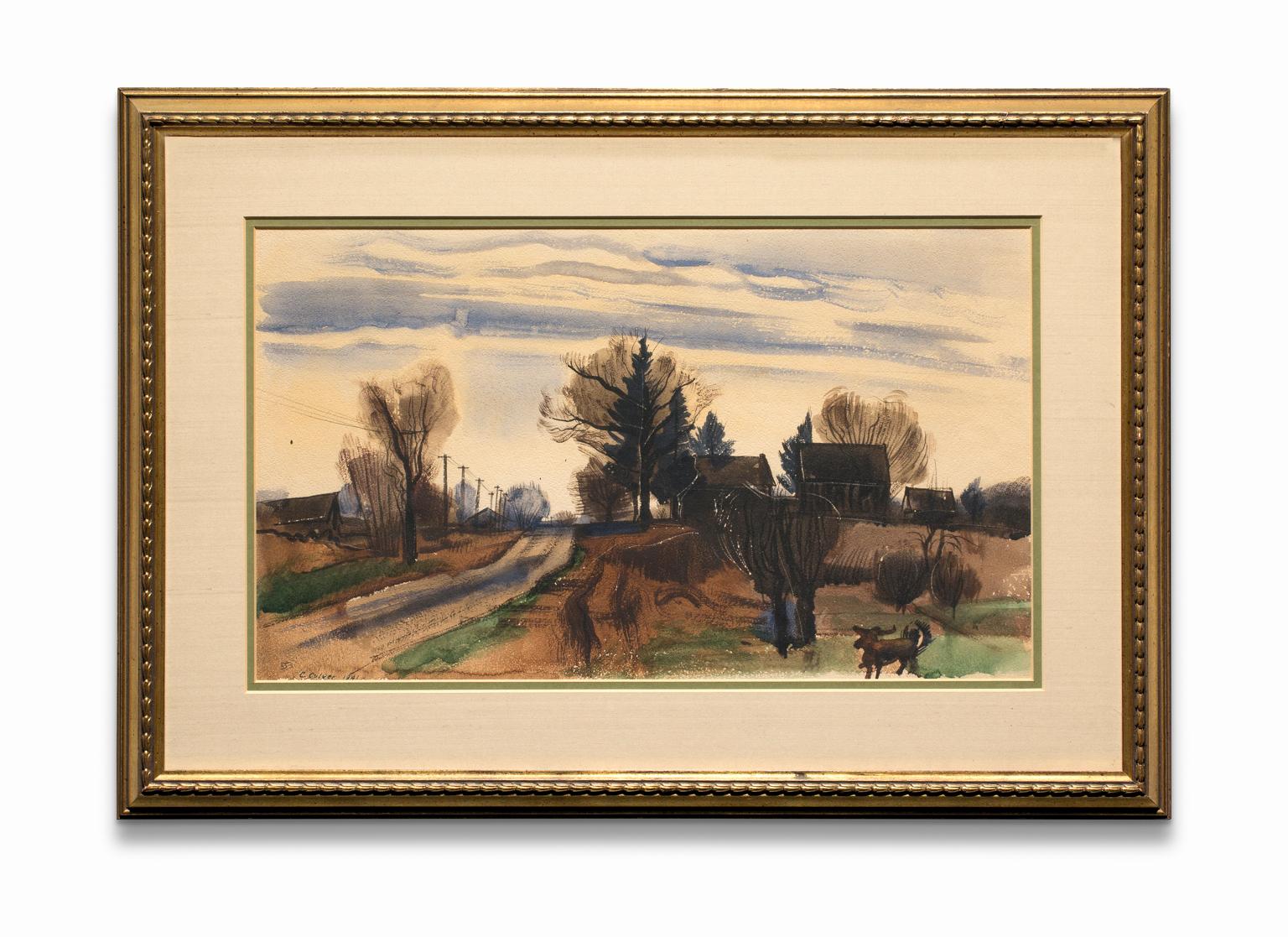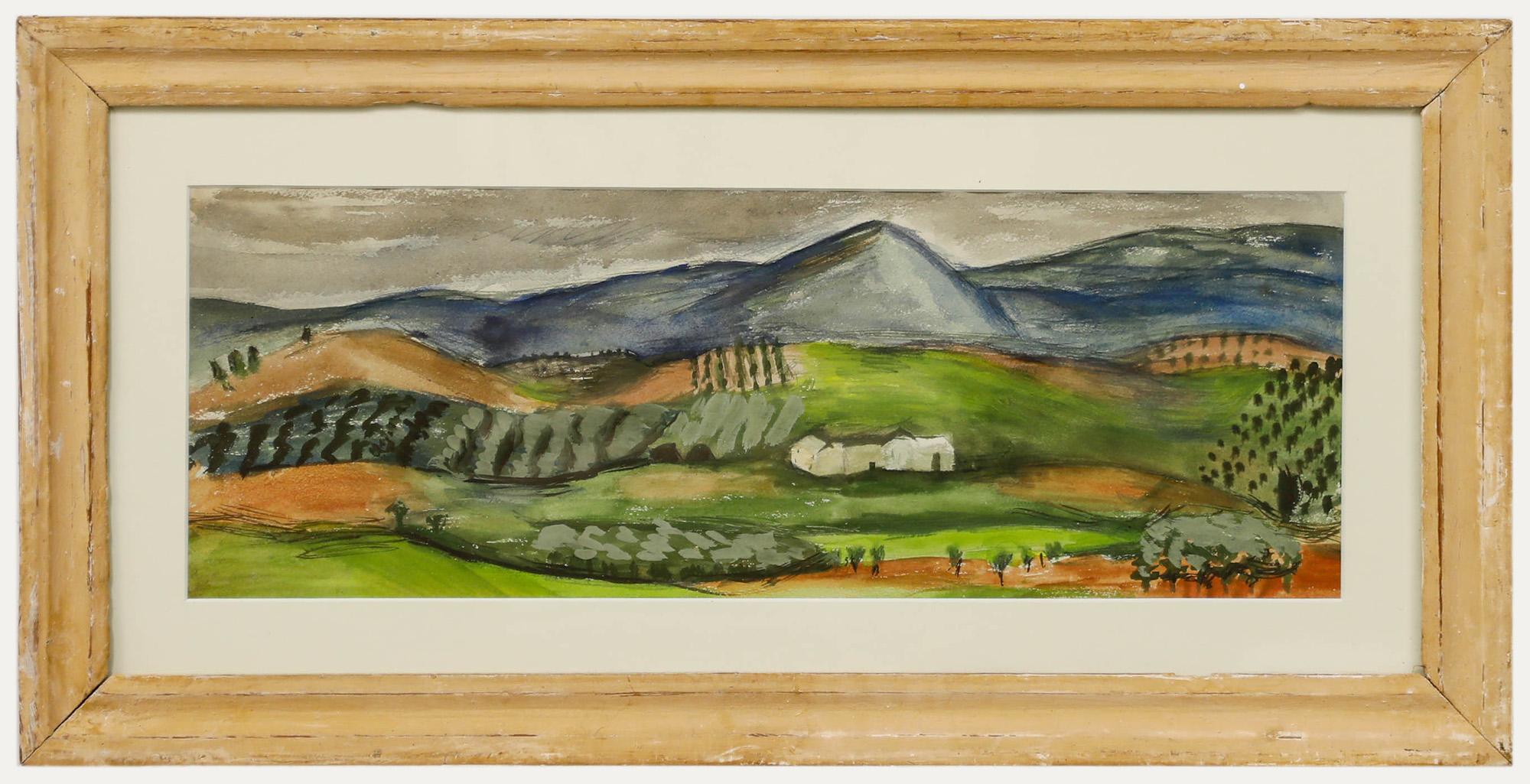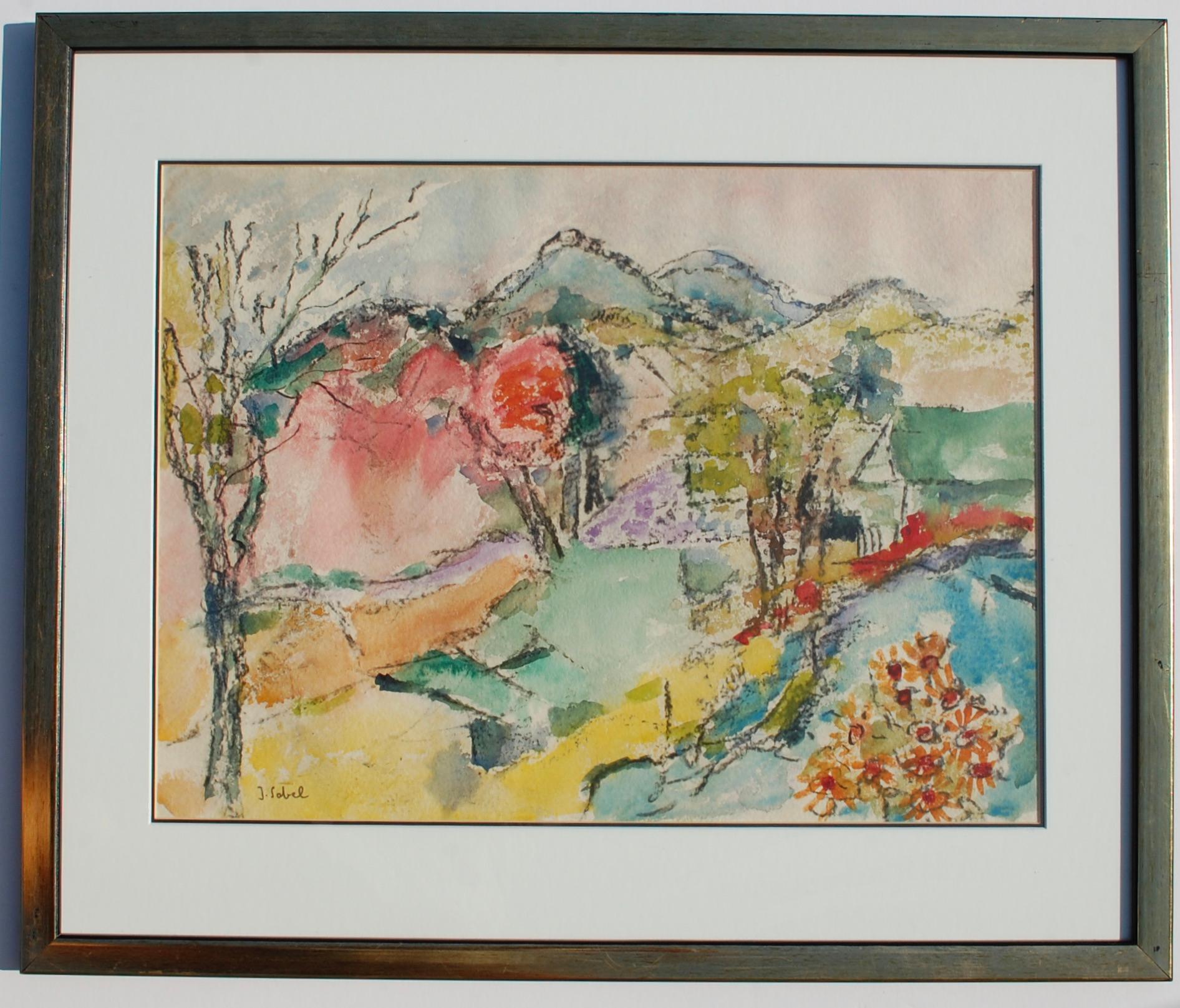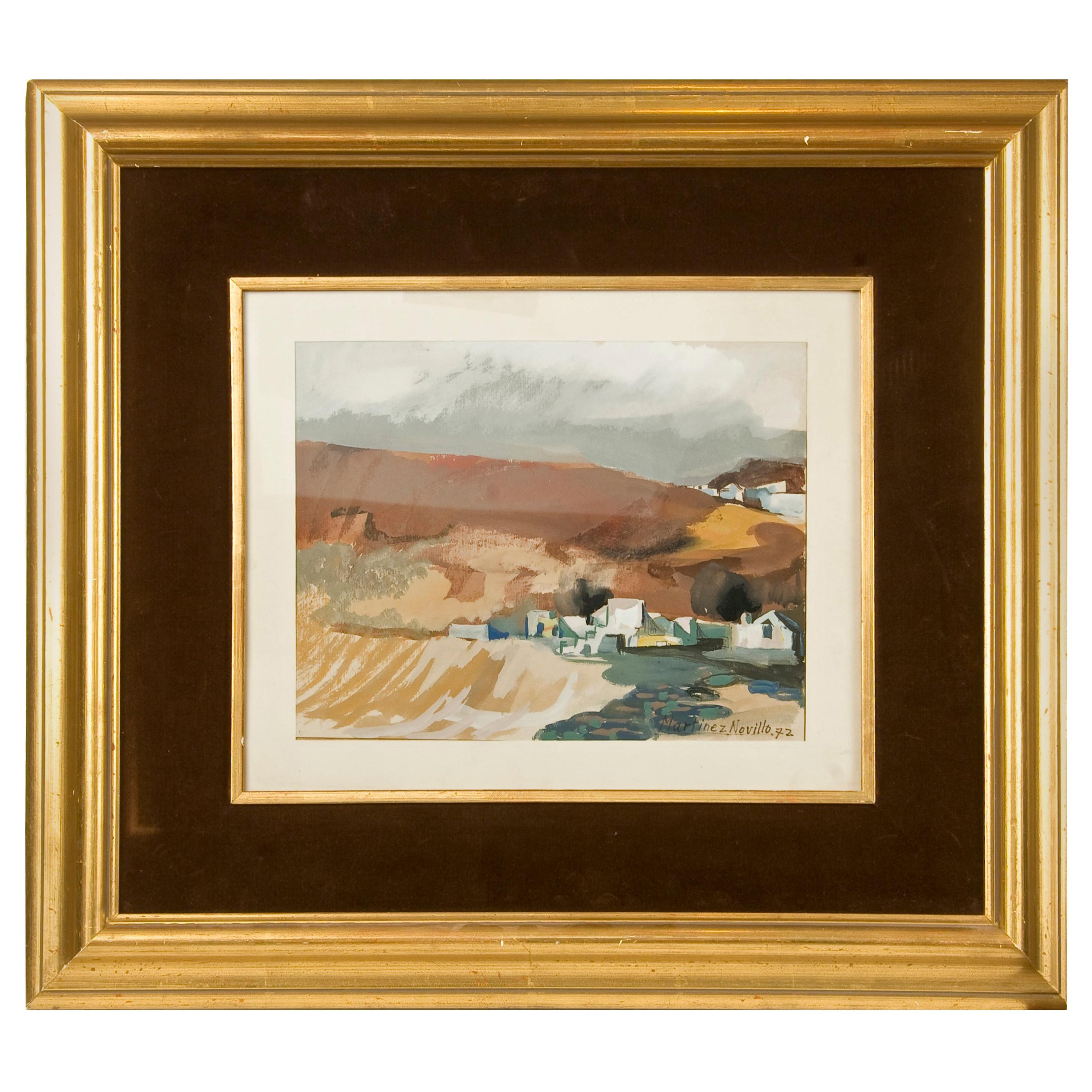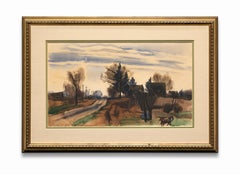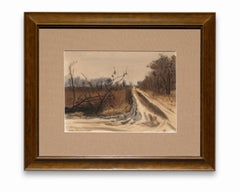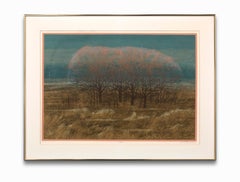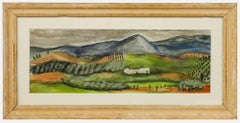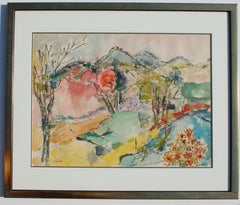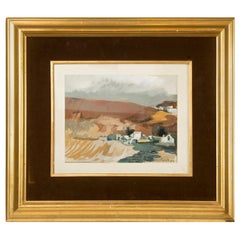Items Similar to Charles Culver Watercolor Landscape "Red Hills Near Patzcurao" Signed & Dated
Want more images or videos?
Request additional images or videos from the seller
1 of 12
Charles CulverCharles Culver Watercolor Landscape "Red Hills Near Patzcurao" Signed & Dated1940
1940
$2,900
£2,181.41
€2,514.44
CA$4,084.97
A$4,482.19
CHF 2,345.77
MX$55,160.53
NOK 29,553.16
SEK 27,680.93
DKK 18,775.04
About the Item
The idyllic atmosphere of this Mexican scene is located in Mexico, west of Mexico City and south of Guadalajara. “Red Hills Near Patzcuaro” is set in a golden light. and was one of three paintings by the artist while the artist visited Patzcuaro, Mexico. The humans depicted lend an atmosphere to the painting and an indication of location - dressed in native Mexican peasant dress - without being obtrusive and causing the viewer to concentrate on them. The intense red hills of Patzcuaro are the feature in this painting along with the pinon and juniper trees and the Chamisa shrub. This piece has been professionally reframed with acid-free matting and museum glass.
In a 1952 Detroit Free Press article, entitled “Artist Explains His Work,” Culver was asked why he painted the way he did. He stated: “I try to ‘see’ though not too exactly; I try to think though not too ponderously; I feel emotion yet I try not to become overwrought. I interpret rather than describe, and design rather than depict. I work with values, not light and shade; hence, when I am successful, I achieve substance rather than three-dimensional form, and this satisfies me as being wholly sufficient. In my work I wish to be serious without becoming a bore, exuberant without being frivolous, humorous without being silly. I believe that good paintings are conceived, not contrived; and I am interested in art much more than in pictures.”
Charles Culver was born in Chicago, 1908, and by his early 20’s was studying commercial art which would provide a skill for a job, but was not his first choice for artistic study. In the 1920s he worked as a cartoonist for the Royal Oak Tribune. He wrote and illustrated several “children’s” books which were really intended for a more adult audience, now called graphic novels a hundred years later. He was also a musician, tenor sax and clarinet, and went on the road with Gene Goldkette. While living in Bellaire, Michigan, in the 1950s he was a regular in jam sessions at a popular local bar.
He worked on and off at the Chevrolet Studios in the General Motors Building in Detroit, located on W. Grand Blvd. near Woodward, as a commercial artist. He did this in order to make enough money to support himself and his wife for a couple years at a time during which he painted full time. He did this work/paint regimen until he finally gained enough recognition by the 1930’s to begin receiving invitations to exhibit his paintings in galleries such as the Gordon Beer Gallery in Detroit, the Detroit Artists Market, the Michigan Artists at the DIA, the Butler Institute of American Art in Youngstown, Ohio, and the International Watercolor Exhibition at the Art Institute of Chicago, to name a few.
In the 50s, he commenced his ten-year teaching career at Arts and Crafts in Detroit, now known as College for Creative Studies. Arts and Crafts was an important formative artistic teaching institution for many local and national artists. Some of the faculty and graduates include Richard Jerzy, Harry Bertoia, Doug Chaing (currently director of Lucas Film), Stephen Dinehart (game maker, writer, designer connected with The David Lynch Foundation), Tyree Guyton (international artist), Herb Babcock, Jerome Feretti, Kevin Siembieda (writer, designer and publisher of role-playing games), Renee Radell, Philip Pearlstein, Charles McGee (nationally recognized African American sculptor of animal and dancing spirits), Philip Pearlstein (2000 Honorary Doctorate, Modern Realism style), John Louis Krieger (American Modern), William Girard (American Modern), Henry Heading, Hughie Lee-Smith, and Joseph Wesner. Culver wrote a monthly newsletter for the faculty and students called Topic and Talk, established his humorous philosophy and vocabulary. He took on the role of art critic for the Detroit Free Press for two years during which he verbally slashed to pieces what he perceived to be the pretensions of avant-garde art.
Culver had over 25 one-man shows in the Detroit area alone, won 14 prizes at the “Exhibition for Michigan Artists” sponsored by the Detroit Institute of Arts, including the Scarab Club Gold Medal in 1940-43, and is represented, according to a curator at the DIA with sole 90 paintings in the DIA’s permanent collection, more than any other Michigan artist. His work is found in museums and private collections both nationally and internationally.
- Creator:Charles Culver (1908 - 1967)
- Creation Year:1940
- Dimensions:Height: 19 in (48.26 cm)Width: 24 in (60.96 cm)
- Medium:
- Movement & Style:
- Period:
- Condition:
- Gallery Location:Detroit, MI
- Reference Number:1stDibs: LU128617986652
About the Seller
5.0
Vetted Professional Seller
Every seller passes strict standards for authenticity and reliability
Established in 2014
1stDibs seller since 2019
108 sales on 1stDibs
Typical response time: 18 hours
- ShippingRetrieving quote...Shipping from: Detroit, MI
- Return Policy
Authenticity Guarantee
In the unlikely event there’s an issue with an item’s authenticity, contact us within 1 year for a full refund. DetailsMoney-Back Guarantee
If your item is not as described, is damaged in transit, or does not arrive, contact us within 7 days for a full refund. Details24-Hour Cancellation
You have a 24-hour grace period in which to reconsider your purchase, with no questions asked.Vetted Professional Sellers
Our world-class sellers must adhere to strict standards for service and quality, maintaining the integrity of our listings.Price-Match Guarantee
If you find that a seller listed the same item for a lower price elsewhere, we’ll match it.Trusted Global Delivery
Our best-in-class carrier network provides specialized shipping options worldwide, including custom delivery.More From This Seller
View AllCharles Culver Landscape "Late Afternoon Landscape" Watercolor on Paper
Located in Detroit, MI
“Late Afternoon Landscape” is set in the golden light of evening painted in the mid-west town of Utica, Michigan. It has the atmosphere of when work is done and peace and quiet blanket the countryside. The The farm machinery has ceased its racket as has the family dog wandering about for one last sniff. This piece has been professionally reframed with acid-free matting and conservative glass.
In a 1952 Detroit Free Press article, entitled “Artist Explains His Work,” Culver was asked why he painted the way he did. He stated: “I try to ‘see’ though not too exactly; I try to think though not too ponderously; I feel emotion yet I try not to become overwrought. I interpret rather than describe, and design rather than depict. I work with values, not light and shade; hence, when I am successful, I achieve substance rather than three-dimensional form, and this satisfies me as being wholly sufficient. In my work I wish to be serious without becoming a bore, exuberant without being frivolous, humorous without being silly. I believe that good paintings are conceived, not contrived; and I am interested in art much more than in pictures.”
Charles Culver...
Category
1940s Naturalistic Landscape Drawings and Watercolors
Materials
Paper, Watercolor
Charles Culver Landscape Winter Road Watercolor Signed & Dated
Located in Detroit, MI
The idyllic atmosphere of this country scene falls within a couple of styles one being regionalism, an American realist modern art movement that included paintings, murals, lithographs, and illustrations depicting scenes of rural and small-town America primarily in the Midwest and frequently associated with Grant Wood and Thomas Hart Benton. The other style is romanticism wherein the scene depicted is a more desired or dramatic version of what actually is. “Untitled (Winter Road)” is a quiet country scene depicting a road leading into the distance either going to or coming from a local farm. The snow does not particularly seem fresh suggesting a melt and the coming of spring.
This piece has been professionally reframed with acid-free matting and conservator glass.
In a 1952 Detroit Free Press article, entitled “Artist Explains His Work,” Culver was asked why he painted the way he did. He stated: “I try to ‘see’ though not too exactly; I try to think though not too ponderously; I feel emotion yet I try not to become overwrought. I interpret rather than describe, and design rather than depict. I work with values, not light and shade; hence, when I am successful, I achieve substance rather than three-dimensional form, and this satisfies me as being wholly sufficient. In my work I wish to be serious without becoming a bore, exuberant without being frivolous, humorous without being silly. I believe that good paintings are conceived, not contrived; and I am interested in art much more than in pictures.”
Charles...
Category
1940s Naturalistic Landscape Drawings and Watercolors
Materials
Paper, Watercolor
"Untitled (Dock Scene)" Watercolor on Paper, Local Scene, Buildings, Water
Located in Detroit, MI
The idyllic atmosphere of this local dock scene falls within a couple of styles one being regionalism, an American realist modern art movement that included paintings, murals, lithographs, and illustrations depicting scenes of rural and small-town America primarily in the Midwest and frequently associated with Grant Wood and Thomas Hart Benton. The other style is romanticism wherein the scene depicted is a more desired or dramatic version of what actually is. “Untitled (Dock Scene)” is typical of a small town dock scene from Michigan where Culver lived or from places as far away as Maine, but what makes it important is its easy familiarity: water, gulls or terns, slanting wood shanties, scruffy dirt patches and course grasses. It is not idealized, but does set the tone of fresh air, the scream of birds and the sun on water. This piece has been professionally reframed with acid-free matting and museum glass.
In a 1952 Detroit Free Press article, entitled “Artist Explains His Work,” Culver was asked why he painted the way he did. He stated: “I try to ‘see’ though not too exactly; I try to think though not too ponderously; I feel emotion yet I try not to become overwrought. I interpret rather than describe, and design rather than depict. I work with values, not light and shade; hence, when I am successful, I achieve substance rather than three-dimensional form, and this satisfies me as being wholly sufficient. In my work I wish to be serious without becoming a bore, exuberant without being frivolous, humorous without being silly. I believe that good paintings are conceived, not contrived; and I am interested in art much more than in pictures.”
Charles Culver...
Category
1940s Naturalistic Landscape Drawings and Watercolors
Materials
Paper, Watercolor
Robert Burkert Lithograph Landscape "Late Light" Poetic
By Robert Burkert
Located in Detroit, MI
"Late Light" by Robert Burkert is a lithograph landscape by the master printmaker that depicts a clearing with autumn/winter trees in the subtle but vib...
Category
Late 20th Century Contemporary Landscape Prints
Materials
Lithograph
"Untitled (Red Flower)" Watercolor on Paper, Abstract Flower, Signed & Dated
Located in Detroit, MI
Flowers were one of Culver's favorite subject. This stunning portrait of a red flower draws the viewer into its very center as powerfully as any flower portrait by Georgia O'Keeffe. It is the idyllic flower that can be described as in the romantic style wherein the subject depicted is a more desired or dramatic version of what actually is. It is signed and dated by the artist on the lower left. This piece has been professionally reframed with acid-free matting and museum glass.
In a 1952 Detroit Free Press article, entitled “Artist Explains His Work,” Culver was asked why he painted the way he did. He stated: “I try to ‘see’ though not too exactly; I try to think though not too ponderously; I feel emotion yet I try not to become overwrought. I interpret rather than describe, and design rather than depict. I work with values, not light and shade; hence, when I am successful, I achieve substance rather than three-dimensional form, and this satisfies me as being wholly sufficient. In my work I wish to be serious without becoming a bore, exuberant without being frivolous, humorous without being silly. I believe that good paintings are conceived, not contrived; and I am interested in art much more than in pictures.”
Charles Culver...
Category
1950s Romantic Still-life Drawings and Watercolors
Materials
Paper, Watercolor
Thomas M Nicholas Winter Country Scene Northeast Oil
Located in Detroit, MI
SALE ONE WEEK ONLY
The untitled oil painting of a quiet country winter scene is a typical subject matter for T. M. Nicholas who is considered by many to be among the most prominent painter of his generation and specifically of the Rockport School of Art. Painting is signed in the lower right front corner.
He grew up admiring the rugged beauty of the U.S. northeast coastline especially the landscapes of coastal New England. His father, esteemed painter, Tom Nicholas...
Category
1990s Landscape Paintings
Materials
Canvas, Oil
You May Also Like
Framed Mid 20th Century Watercolour - Rolling Hills
Located in Corsham, GB
Naïve mid-century landscape, watercolour and gouache. Unsigned. Well presented in a distressed wooden frame.
Category
20th Century Landscape Drawings and Watercolors
Materials
Watercolor
Watercolor Country Landscape, C. 1950
Located in Houston, TX
This lovely watercolor, circa 1950, combines soft colors and impressionistic brushstrokes to provide a peaceful view of the rolling countryside. The emerald green line of trees leads...
Category
1950s Landscape Drawings and Watercolors
Materials
Watercolor, Paper
Mountain View Landscape Watercolor 1960
By Jehudith Sobel
Located in Lake Worth Beach, FL
Mountain View With Flowers
watercolor 1960's
18.5x23.5 framed 25x30x1
Judith Sobel was born in Lwow Poland in 1924. After World War II, she attended the Academy of Fine Arts in Lodz...
Category
1960s Impressionist Landscape Drawings and Watercolors
Materials
Paper, Watercolor
"Landscape", 1972, Watercolor, Signed and Dated, Martínez Novillo, Cirilo
By Cirilo Martínez Novillo
Located in Madrid, ES
Martínez Novillo, Cirilo (Madrid, 1921-2008).
"Landscape", 1972.
Watercolor. Signed and dated in the lower right corner.
Cirilo Martínez Novillo is one of the most outstanding ...
Category
Vintage 1970s Spanish Other Contemporary Art
Materials
Other
California Hills, Mid Century Landscape Watercolor
Located in Soquel, CA
Vibrant watercolor by an unknown artist, in the style of Elmer Wachtel (American, 1864 - 1929). This mid-century landscape watercolor features a golden yellow meadow beside a country...
Category
Mid-20th Century American Impressionist Landscape Drawings and Watercolors
Materials
Watercolor, Laid Paper
California Valley, Near Capistrano, 20th Century Western Mountainous Landscape
By Frank Wilcox
Located in Beachwood, OH
Frank Nelson Wilcox (American, 1887–1964)
California Valley, Near Capistrano, c. 1937
Watercolor on paper
Signed lower right, titled verso
15 x 20 inches
18.5 x 24 inches framed
Fr...
Category
1930s American Modern Landscape Drawings and Watercolors
Materials
Watercolor
